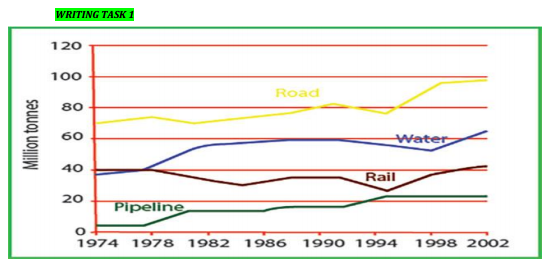The graph above shows the quantities of goods transported in the UK between 1974 and 2002 by four different modes of transport.
The line graph shows the information about the number of materials that transported based on four vary modes of transport in the UK, between 1974 and 2002. The unit of data is measured in million tonnes. Overall, there are upward trend of road and gradual fluctuation of rail.
According to the graph, it can be seen that the highest of number of goods is road, which is started at 65 in the first year and it peaked in 1998 and raised slightly up to 100. In 2002, water and rail have quantities which is almost same, but water bit fewer than rail. Than it rose dramatically from 40 in 1978 to 58 in 1982 and it peaked up to 65 in 2002.
There was an fluctuation of the number of rail from 1974 to 1994, however it inclined sharply about 25 up to over 40 in the end of year. The least is pipeline which is just under 10 in the first year, then rose significantly and peaked in 1994 at over 20, but in the next year it stood until the end of period. (185w)
The line graph shows the information about the number of materials that transported based on four vary modes of transport in the UK, between 1974 and 2002. The unit of data is measured in million tonnes. Overall, there are upward trend of road and gradual fluctuation of rail.
According to the graph, it can be seen that the highest of number of goods is road, which is started at 65 in the first year and it peaked in 1998 and raised slightly up to 100. In 2002, water and rail have quantities which is almost same, but water bit fewer than rail. Than it rose dramatically from 40 in 1978 to 58 in 1982 and it peaked up to 65 in 2002.
There was an fluctuation of the number of rail from 1974 to 1994, however it inclined sharply about 25 up to over 40 in the end of year. The least is pipeline which is just under 10 in the first year, then rose significantly and peaked in 1994 at over 20, but in the next year it stood until the end of period. (185w)

Line_graph.png
